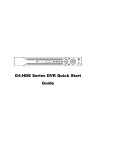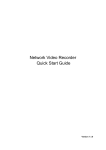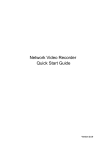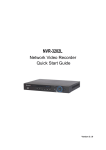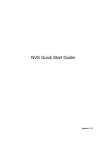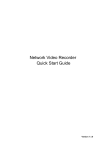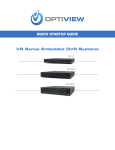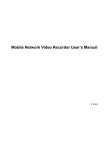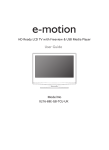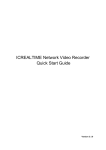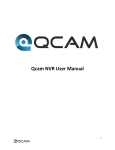Download Hybrid Standalone DVR Quick Start Guide
Transcript
Hybrid Standalone DVR Quick Start Guide V1.1.0 Table of Contents 1 INSTALLATION AND CONNECTIONS .................................................... 1 1.1 Check Unpacked DVR...............................................................................................................1 1.2 About Front Panel and Real Panel..........................................................................................1 1.3 HDD Installation..........................................................................................................................1 1.4 Rack Installation .........................................................................................................................2 1.5 Front Panel ..................................................................................................................................2 1.6 Rear Panel...................................................................................................................................4 1.6.1 General Series .......................................................................................................................5 1.6.2 HD-SDI Series........................................................................................................................5 1.6.3 960H Series ............................................................................................................................6 1.7 Connection Sample....................................................................................................................7 1.8 Alarm Input and Output Connection......................................................................................10 1.8.1 Alarm Input and Output Details.........................................................................................10 1.8.2 Alarm Input Port ...................................................................................................................10 1.8.3 Alarm Output Port................................................................................................................11 2 OVERVIEW OF NAVIGATION AND CONTROLS .................................. 12 2.1 Login, Logout & Main Menu....................................................................................................12 2.1.1 Login ......................................................................................................................................12 2.1.2 Logout ....................................................................................................................................13 2.1.3 Live Viewing..........................................................................................................................14 2.2 Schedule ....................................................................................................................................14 i 2.3 Manual Record..........................................................................................................................15 2.4 Encode .......................................................................................................................................15 2.5 Snapshot ....................................................................................................................................17 2.5.1 Schedule Snapshot .............................................................................................................17 2.5.2 Activation Snapshot ............................................................................................................18 2.5.3 Priority....................................................................................................................................19 2.5.4 Image FTP ............................................................................................................................19 2.5.5 Snapshot Disk (For special series only) ..........................................................................19 2.6 Search & Playback...................................................................................................................20 2.7 Network .....................................................................................................................................24 2.8 PTZ Control and Color Setup.................................................................................................25 PTZ Setup............................................................................................................................................25 3D Intelligent Positioning Key ..........................................................................................................28 2.9 3 Remote Device ........................................................................................................................28 WEB CLIENT OPERATION .................................................................... 29 3.1 Network Connection.................................................................................................................29 3.2 Login ...........................................................................................................................................29 3.3 Log out........................................................................................................................................31 APPENDIX H TOXIC OR HAZARDOUS MATERIALS OR ELEMENTS ....... 32 ii Welcome Thank you for purchasing our DVR! This user’s manual is designed to be a reference tool for the installation and operation of your system. Here you can find information about this series hybrid standalone DVR features and functions, as well as a detailed menu tree. Before installation and operation please read the following safeguards and warnings carefully! iii Important Safeguards and Warnings 1.Electrical safety All installation and operation here should conform to your local electrical safety codes. We assume no liability or responsibility for all the fires or electrical shock caused by improper handling or installation. 2.Transportation security Heavy stress, violent vibration or water splash are not allowed during transportation, storage and installation. 3.Installation Keep upwards. Handle with care. Do not apply power to the DVR before completing installation. Do not place objects on the DVR 4.Qualified engineers needed All the examination and repair work should be done by the qualified service engineers. We are not liable for any problems caused by unauthorized modifications or attempted repair. 5.Environment The DVR should be installed in a cool, dry place away from direct sunlight, inflammable, explosive substances and etc. 6. Accessories Be sure to use all the accessories recommended by manufacturer. Before installation, please open the package and check all the components are included. Contact your local retailer ASAP if something is broken in your package. 7. Lithium battery Improper battery use may result in fire, explosion, or personal injury! When replace the battery, please make sure you are using the same model! iv 1 Installation and Connections Note: All the installation and operations here should conform to your local electric safety rules. 1.1 Check Unpacked DVR When you receive the DVR from the forwarding agent, please check whether there is any visible damage. The protective materials used for the package of the DVR can protect most accidental clashes during transportation. Then you can open the box to check the accessories. Please check the items in accordance with the list on the warranty card. Finally you can remove the protective film of the DVR. Note Remote control is not a standard accessory and it is not included in the accessory bag. 1.2 About Front Panel and Real Panel The model in the front panel is very important; please check according to your purchase order. The label in the rear panel is very important too. Usually we need you to represent the serial number when we provide the service after sales. 1.3 HDD Installation This series DVR has 1 to 8 HDDs(no limitation for capacity). Please use HDD of 7200rpm or higher. Usually we do not recommend the HDD for the PC. You can refer to the Appendix for recommended HDD brand. Please follow the instructions listed below to install hard disk. 1. Loosen the screws of the upper cover. 2. Loosen HDD upper bracket 3. You can see the HDD lower support after loosening HDD upper bracket 1 4. Place the HDD in accordance 5. Fix the HDD firmly with screws. 6. Install the upper support and fix it to the four holes on the lower firmly. Fix the HDD to the HDD upper bracket support in the same way. 7.Loosen the HDD power wire 8. Insert the power wire inside the DVR. 9. Connect HDD to SATA port with specified data line, then put the cover on the box and fix it firmly. Note: You can connect the HDD data cable and the power cable first and then fix the HDD in the device. Please pay attention to the front cover. It adopts the vertical sliding design. You need to push the clip first and then put down. 1.4 Rack Installation The DVR occupies 2U rack units of vertical rack space. Use twelve screws to fix the unit Please make sure the indoor temperature is below 35℃ (95°f). Please make sure there is 15cm (6 inches) space around the device to guarantee sound ventilation. Please install from the bottom to the top. If there are more accessories connected in the rack, please take precaution measures in case the rack power is overload. 1.5 Front Panel This series products’ front panel are shown as below. See Figure 1-1. Figure 1-1 Please refer to the following sheet for front panel button information. Name Icon Function 2 Power button, press this button for three seconds to boot up or shut down DVR. Power button Number button 0-9 Input Arabic number Switch channel Input number more than 10 -/-- If you want to input a number more than 10, please click this button and then input. Shift In textbox, click this button to switch between numeral, English(Small/Capitalized),donation and etc. Enable or disable tour. Fast play Various fast speeds and normal playback. Multiple slow play speeds or normal playback. Slow play Play/Pause In normal playback click this button to pause playback In pause mode, click this button to resume playback. Reverse/Pause In normal playback or pause mode, click this button to reverse playback In reverse playback, click this button to pause playback. Play previous In playback mode, playback the previous video In playback mode, playback the next video In menu setup, go to down ward of the dropdown list. Play Next Up/ Down Activate current control, modify setup, and then move up and down. 、 Increase/decrease numeral. Assistant function such as PTZ menu. Shift current activated control, and then move left and right. Left/ Right ESC ESC When playback, click these buttons to control playback bar. Go to previous menu, or cancel current operation. When playback, click it to restore real-time monitor mode. Confirm current operation Enter ENTER Go to default button Go to menu Assistant Fn One-window monitor mode, click this button to display assistant function: PTZ control and image color 3 Backspace function: in numeral control or text control, press it for 1.5 seconds to delete the previous character before the cursor. In motion detection setup, working with Fn and direction keys to realize setup. In text mode, click it to switch between numeral, English character(small/capitalized) and etc. In HDD management interface, you can click it to switch HDD record information and other information (Menu prompt) Realize other special functions. Record REC Manually stop/start recording, working with direction keys or numeral keys to select the recording channel. Window switch Mult Click it to switch one-window/multiple-window. In real-time monitor mode it works as left/right direction key. Playback mode, counter clockwise to forward and clock wise to backward. Shuttle(outer ring) Up/down direction key. Playback mode, turn the inner dial to realized frame by frame playback. (Only applies to some special versions.) Jog(inner dial) USB port To connect USB storage device, USB mouse, burner and etc. For 4/8/16 channel device: indication light on means that the channel is in recording. For 32 channel device: Indication Light on: 1-16 channel is in recording Indication Light flashes: 17-32 channel is in recording Indication Light normally on: the corresponding channels are in recording Record light 1-32 Remote control indication light ACT Remote control indication light Status indication light Status If there is Fn indication light, current status indication light is null. Power indication light PWR Power indication light IR Receiver IR It is to receive the signal from the remote control. 1.6 Rear Panel 4 1.6.1 General Series This series products’ rear panel is shown as below. See Figure 1-2 Figure 1-2 Please refer to the following sheet for detailed information. 1 Grounding hole 2 Power input port 3 Power button 4 Fan 5 The 1st to the 4th-channel audio input 6 DB25 port (the 5th to the 16th-channel audio input port) 7 Loop video output 8 Video input 9 Audio output 10 Bidirectional talk input port 11 Bidirectional talk output port 12 Alarm input/alarm output 13 Video VGA output 14 HDMI port 15 RS-232 port 16 eSATA port 17 USB port 18 Network port 19 Video CVBS output 20 Video matrix output 21 Full duplex RS-485 port 22 Half duplex RS-485 port 1.6.2 HD-SDI Series This series products’ rear panel is shown as below. See Figure 1-3. Please note there is a special series product has only two audio ports. 5 Figure 1-3 Please refer to the following sheet for detailed information. 1 Grounding hole 2 Power input port 3 Power button 4 Fan 5 Video input 6 Loop video output 7 Audio input 8 Bidirectional talk input port 9 Bidirectional talk output port 10 Video output 11 Audio output 12 Alarm input/alarm output/RS485 port 13 Network port 14 Video VGA output 15 HDMI port 16 USB port 17 eSATA port 18 RS-232 port 1.6.3 960H Series This series products’ rear panel is shown as below. See Figure 1-4. Please note there is a special series product does not have the DB25 port. Figure 1-4 6 Please refer to the following sheet for detailed information. 1 Grounding hole 2 Power input port 3 Power button 4 Fan 5 DB25 port (the 5th to the 16th-channel audio input port) 6 The 1st to the 4th-channel audio input 7 Loop video output 8 Video input 9 Video CVBS output 10 Video matrix output 11 Audio output 12 Bidirectional talk input port 13 Bidirectional talk output port 14 Alarm input/alarm output/RS485 port 15 Video VGA output 16 HDMI port 17 RS-232 port 18 eSATA port 19 USB port 20 Network port When connect the Ethernet port, please use crossover cable to connect the PC and use the straight cable to connect to the switcher or router. 1.7 Connection Sample 7 General Series 8 HD-SDI Series 960H Series Figure 1-5 9 1.8 Alarm Input and Output Connection 1.8.1 Alarm Input and Output Details Important Please refer to the specifications for the alarm input and output channel amount. Do not merely count the alarm input and out channel amount according to the ports on the rear panel. Figure 1-6 In the first line, from ALARM 1 to ALARM 16. The alarm becomes active in low voltage. the left to the right,: 1,2,3,4,5,6, 7,8,9,10,11, 12,13,14,15,16 In the second line, from the left to the right: NO1 C1, NO2 C2, NO3 C3, NO4 C4, NO5 C5 NC5 The first four are four groups of normal open activation output (on/off button) NO5 C5 NC5 is a group of NO/NC activation output (on/off button) CTRL 12V Control power output. You need to close the device power to cancel the alarm. +12V It is external power input. Need the peripheral equipment to provide +12V power (below 1A). Earth cable. 485 A/B 485 communication port. They are used to control devices such as decoder. T+,T-,R+,R- They are four-wire double duplex RS485 port T+ T-: output wire R+ R-: input wire 1.8.2 Alarm Input Port Please refer to the following sheet for more information. Grounding alarm inputs. Normal open or Normal close type) 10 Please parallel connect COM end and GND end of the alarm detector (Provide external power to the alarm detector). Please parallel connect the Ground of the DVR and the ground of the alarm detector. Please connect the NC port of the alarm sensor to the DVR alarm input(ALARM) Use the same ground with that of DVR if you use external power to the alarm device. Figure 1-7 1.8.3 Alarm Output Port Provide external power to external alarm device. To avoid overloading, please read the following relay parameters sheet carefully. RS485 A/B cable is for the A/B cable of the PTZ decoder. T+,T-,R+,R- are four-wire double duplex RS485 port. T+ T-: output wire R+ R-: input wire 11 2 Overview of Navigation and Controls Before operation, please make sure: You have properly installed HDD and all the cable connections. The provided input power and the device power are matched. The external power shall be DC 12V. Always use the stable current, if necessary UPS is a best alternative measure. 2.1 Login, Logout & Main Menu 2.1.1 Login After system booted up, system pops up the startup wizard. Click the Cancel button; you can go to the system login interface. Click the Next Step button; you can go to the startup wizard interface. Here you can set the system basic information. See Figure 2-1. Figure 2-1 The system login interface is shown as in Figure 2-2. System consists of four accounts: Username: admin. Password: admin. (administrator, local and network) Username: 888888. Password: 888888. (administrator, local only) Username: 666666. Passwords: 666666(Lower authority user who can only monitor, playback, backup and etc.) Username: default. Password: default(hidden user) You can use USB mouse, front panel, remote control or keyboard to input. About input method: Click to switch between numeral, English character (small/capitalized) and denotation. Note: For security reason, please modify password after you first login. Within 30 minutes, three times login failure will result in system alarm and five times login failure will result in account lock! 12 Figure 2-2 2.1.2 Logout There are two ways for you to log out. One is from menu option: In the main menu, click shutdown button, you can see an interface is shown as below. See Figure 2-3. Figure 2-3 There are several options for you. See Figure 2-4. Figure 2-4 The other ways is to press power button on the front panel for at least 3 seconds, system will stop all operations. Then you can click the power button in the rear panel to turn off the DVR. 2.1.2.1 Auto Resume after Power Failure The system can automatically backup video and resume previous working status after power failure. 2.1.2.2 Replace Button Battery Please make sure to use the same battery model if possible. We recommend replace battery regularly (such as one-year) to guarantee system time accuracy. Note: Before replacement, please save the system setup, otherwise, you may lose the data completely! 13 2.1.3 Live Viewing After you logged in, the system is in live viewing mode. You can see system date, time and channel name. If you want to change system date and time, you can refer to general settings (Main Menu->Setting->General). If you want to modify the channel name, please refer to the display settings (Main Menu->Setting->Display) 1 Recording status 3 Video loss 2 Motion detection 4 Camera lock 2.2 Schedule After system booted up, it is in default 24-hour regular mode. You can set record type and time in schedule interface. In the main menu, from setting to schedule, you can go to schedule menu. See Figure 2-5. Channel: Please select the channel number first. You can select “all” if you want to set for the whole channels. Week day: There are eight options: ranges from Saturday to Sunday and all. Pre-record: System can pre-record the video before the event occurs into the file. The value ranges from 1 to 30 seconds depending on the bit stream. Redundancy: System supports redundancy backup function. It allows you backup recorded file in two disks. You can highlight Redundancy button to activate this function. Please note, before enable this function, please set at least one HDD as redundant. (Main menu->Advanced->HDD Management). Snapshot: You can enable this function to snapshoot image when alarm occurs. Record types: There are four types: regular, motion detection (MD), Alarm, MD & alarm. Please highlight icon to select the corresponding function. After completing all the setups please click save button, system goes back to the previous menu. At the bottom of the menu, there are color bars for your reference. Green color stands for regular recording, yellow color stands for motion detection and red color stands for alarm recording. The white means the MD and alarm record is valid. Once you have set to record when the MD and alarm occurs, system will not record neither motion detect occurs nor the alarm occurs. 14 Figure 2-5 2.3 Manual Record Note: Please make sure you have the record operation right and you have properly installed the formatted HDD. You can right click mouse or in the main menu, from Advanced->Manual Record to go to record interface. There are three statuses: schedule/manual/stop. Highlight icon“○” to select corresponding channel. Manual: The highest priority. After manual setup, all selected channels will begin ordinary recording. Schedule: Channel records as you have set in recording setup (Main Menu->Setting->Schedule) Stop: All channels stop recording. Figure 2-6 2.4 Encode Encode setting includes the following items. Please note some series do not support extra stream. Channel: Select the channel you want. 15 Type: Please select from the dropdown list. There are three options: regular/motion detect/alarm. You can set the various encode parameters for different record types. Compression: System supports H.264. Resolution: System supports various resolutions, you can select from the dropdown list. Please note the option may vary due to different series. The general series The main stream supports D1/HD1/2CIF/CIF/QCIF and the 1-16-channel extra stream supports CIF/QCIF. The HD-SDI series The main stream supports 1080P/720P/D1/HD/2CIF/CIF/QCIF and the extra stream supports 1080P/720P/D1/HD1/2CIF/CIF/QCIF. The 960H series The main stream supports 960H/D1/HD1/2CIF/CIF/QCIF and the extra stream supports 960H/D1/HD1/2CIF/CIF/QCIF. Frame rate: It ranges from 1f/s to 25f/s in NTSC mode and 1f/s to 30f/s in PAL mode. Bit rate type: System supports two types: CBR and VBR. In VBR mode, you can set video quality. Quality: There are six levels ranging from 1 to 6. The sixth level has the highest image quality. Video/audio: You can enable or disable the video/audio. Overlay: Click overlay button Cover area (Privacy mask): Here is for you to set privacy mask section. You can drag you mouse to set proper section size. In one channel video, system max supports 4 zones in one channel. Preview/monitor: privacy mask has two types. Preview and Monitor. Preview means the privacy mask zone can not be viewed by user when system is in preview status. Monitor means the privacy mask zone can not be view by the user when system is in monitor status. Time display: You can select system displays time or not when you playback. Please click set button and then drag the title to the corresponding position in the screen. Channel display: You can select system displays channel number or not when you playback. Please click set button and then drag the title to the corresponding position in the screen. Please highlight icon to select the corresponding function. 16 Figure 2-7 Figure 2-8 2.5 Snapshot 2.5.1 Schedule Snapshot In Encode interface, click snapshot button to input snapshot mode, size, quality and frequency. In General interface please input upload interval. In Schedule interface, please enable snapshot function. Please refer to the following figure for detailed information. See Figure 2-9. Please note, for the 960H series product, the image size has a 960H option. 17 Figure 2-9 2.5.2 Activation Snapshot Please follow the steps listed below to enable the activation snapshot function. After you enabled this function, system can snapshot when the corresponding alarm occurred. In Encode interface, click snapshot button to input snapshot mode, size, quality and frequency. In General interface please input upload interval. In Detect interface please enable snapshot function for specified channels. Or in alarm interface please enable snapshot function for specified channels. Please refer to the following figure for detailed information. See Figure 2-10. Figure 2-10 18 2.5.3 Priority Please note the activation snapshot has the higher priority than schedule snapshot. If you have enabled these two types at the same time, system can activate the activation snapshot when alarm occurs, and otherwise system just operates the schedule snapshot. 2.5.4 Image FTP In Network interface, you can set FTP server information. Please enable FTP function and then click save button. See Figure 2-11. Please boot up corresponding FTP server. Please enable schedule snapshot (Chapter 4.4.2.1) or activation snapshot (Chapter 4.4.2.2) first, now system can upload the image file to the FTP server. Please input the corresponding information here, if you just upload the image FTP. Figure 2-11 2.5.5 Snapshot Disk (For special series only) Set one disk as snapshot (Main menu->Advanced->HDD management) and then click execute button. See Figure 2-12. System needs to reboot to get current setup activated. Figure 2-12 All scheduled snapshot files or activated snapshot files will be memorized in the snapshot disk. 19 You can search the corresponding images via Web. See Figure 2-13. Select a file and then click here to view image content. Select search engine here You can see result here. Double click file name, you can view the image content. Figure 2-13 There are max 100 files in one page. Click here to view more. 2.6 Search & Playback Click search button in the main menu, search interface is shown as below. See Figure 2-14. Usually there are three file types: R: Regular recording file. A: External alarm recording file. M: Motion detection recording file 20 2 3 1 1 4 5 6 7 10 11 8 9 12 Figure 2-14 Please refer to the following sheet for more information. SN 1 2 3 4 Name Function Display window Here is to display the searched picture or file. Support 1/4/9/16-window playback. Search type Here you can select to search the picture or the recorded file. When there is displayed picture on the left pane, you can set the corresponding setup Calendar The blue highlighted date means there is picture or file. Otherwise, there is no picture or file. In any play mode, click the date you want to see, you can see the corresponding record file trace in the time bar. Playback mode and channel selection pane. Playback mode:1/4/9/16. (It may vary due to different series.) In 1-window playback mode: you can select 1-16 channels. In 4-window playback mode: you can select 4 channels according to your requirement. In 9-window playback mode, you can switch between 1-9 and 10-16 channels. In 16-window playback mode, you can switch between1-16 and 17-32 channels. The time bar will change once you modify the playback mode or the channel 21 option. 5 File list switch button 6 Card number search 7 Playback control pane. Double click it, you can view the picture/record file list of current day. The file list is to display the first channel of the record file. The system can display max 128 files in one time. Use the / or the mouse to view the file. Select one item, and then double click the mouse or click the ENTER button to playback. You can input the period in the following interface to begin accurate search. File type:R—regular record; A—external alarm record;M—Motion detect record. The card number search interface is shown as below. ►/ Play/Pause There are three ways for you to begin playback. The play button Double click the valid period of the time bar. Double click the item in the file list. In slow play mode, click it to switch between play/pause. ■ Stop Backward play In normal play mode, left click the button, the file begins backward play. Click it again to pause current play. In backward play mode, click ►/ to restore normal play. │/ │ ► In playback mode, click it to play the next or the previous section. You can click continuously when you are watching the files from the same channel. In normal play mode, when you pause current play, you can click │ and │ to begin frame by frame playback. In frame by frame playback mode, click ►/ to restore normal playback. Slow play In playback mode, click it to realize various slow play modes such as slow play 1, slow play 2, and etc. Fast forward In playback mode, click to realize various fast play modes such as fast play 1,fast play 2 and etc. Note: The actual play speed has relationship with the software version. Smart search The volume of the playback Click the snapshot button in the full-screen mode, the system can snapshot 1 picture per second. 22 Time bar It is to display the record type and its period in current search criteria. In 4-window playback mode, there are corresponding four time bars. In other playback mode, there is only one time bar. Use the mouse to click one point of the color zone in the time bar, system begins playback. The time bar is beginning with 0 o'clock when you are setting the configuration. The time bar zooms in the period of the current playback time when you are playing the file. The green color stands for the regular record file. The red color stands for the external alarm record file. The yellow stands for the motion detect record file. Time bar unit ●The option includes: 24H, 12H, 1H and 30M. The smaller the unit, the larger the zoom rate. You can accurately set the time in the time bar to playback the record. The time bar is beginning with 0 o'clock when you are setting the configuration. The time bar zooms in the period of the current playback time when you are playing the file. Backup Select the file(s) you want to backup from the file list. System max supports files from four channels. Then click the backup button, now you can see the backup menu. Click the start button to begin the backup operation. Check the file again you can cancel current selection. System max supports to display 32 files from one channel. 11 Clip It is to edit the file. ●Please play the file you want to edit and then click this button when you want to edit. You can see the corresponding slide bar in the time bar of the corresponding channel. You can adjust the slide bar or input the accurate time to set the file end time. Click this button again and then save current contents in a new file. . 12 Record type In any play mode, the time bar will change once you modify the search type. 8 9 10 13 Smart search When system is playing, you can select a zone in the window to begin motion detect. Click the motion detect button to begin play. Current button is null once the motion detect play has begun. The system will take the whole play zone as the motion detect region by default. The motion detect play stopped once you switch the play file. Operations such as set time bar, click the play button, or any file list operation will stop current motion detect play. Other Functions 14 15 Other channel synchronization switch to play when playback When playing the file, click the number button, system can switch to the same period of the corresponding channel to play. Digital zoom When the system is in full-screen playback mode, left click the mouse in the screen. Drag your mouse in the screen to select a section and then left click mouse to realize digital zoom. You can right click mouse to exit. 23 Note: All the operations here (such as playback speed, channel, time and progress) have relationship with hardware version. Some series DVRs do not support some functions or playback speeds. 2.7 Network Here is for you to input network information. See Figure 2-15. Network Mode : Includes multiple access, fault tolerance, and load balancing Default Network Card: Please select eth0/eth1/bond0(optional) after enable multiple-access function Main Network Card: Please select eth0/eth1 (optional).after enable multiple access function. Note: The 960H series support the above three configurations and supports functions as multiple-access, fault-tolerance and load balancing. IP address: Here you can input IP address. DHCP: It is to auto search IP. When enable DHCP function, you can not modify IP/Subnet mask /Gateway. These values are from DHCP function. If you have not enabled DHCP function, IP/Subnet mask/Gateway display as zero. You need to disable DHCP function to view current IP information. Besides, when PPPoE is operating, you can not modify IP/Subnet mask /Gateway. TCP port: Default value is 37777. UDP port: Default value is 37778. HTTP port: Default value is 80. RTSP port: Default value is 554. Max connection: system support maximal 20 users. 0 means there is no connection limit. Preferred DNS server: DNS server IP address. Alternate DNS server: DNS server alternate address. Transfer mode: Here you can select the priority between fluency/video qualities. LAN download: System can process the downloaded data first if you enable this function. The download speed is 1.5X or 2.0X of the normal speed. After completing all the setups please click save button, system goes back to the previous menu. 24 960H Series Figure 2-15 2.8 PTZ Control and Color Setup Note: All the operations here are based on PELCOD protocol. For other protocols, there might be a little difference. PTZ Setup 25 Note: The camera video should be in the current screen. Before setup, please check the following connections are right: PTZ and decoder connection is right. Decoder address setup is right. Decoder A (B) line connects with DVR A (B) line. Boot up the DVR, input user name and password. In the main menu, click setting, and then click Pan/Tilt Control button. The interface is shown as in Figure 2-16. Here you can set the following items: Channel: select the current camera channel. Protocol: select corresponding PTZ protocol(such as PELCOD) Address: default address is 1. Baud rate: select corresponding baud rate. Default value is 9600. Data bits: select corresponding data bits. Default value is 8. Stop bits: select corresponding stop bits. Default value is 1. Parity: there are three options: odd/even/none. Default setup is none. Figure 2-16 After completing all the setting please click save button. In one window display mode, right click mouse (click “Fn” Button in the front panel or click “Fn” key in the remote control). The interface is shown as in Figure 2-17. 26 Figure 2-17 Click Pan/Tilt/Zoom, the interface is shown as below. See Figure 2-18. Here you can set the following items: Step: value ranges fro 1 to 8. Zoom Focus Iris and to adjust zoom, focus and iris. Please click icon Figure 2-18 In Figure 2-18, please click direction arrows (See Figure 2-19) to adjust PTZ position. There are total 8 direction arrows. Figure 2-19 27 3D Intelligent Positioning Key In the middle of the eight direction arrows, there is a 3D intelligent positioning key. SeeFigure 2-20. Please make sure your protocol supports this function and you need to use mouse to control. Click this key, system goes back to the single screen mode. Drag the mouse in the screen to adjust section size. The dragged zone supports 4X to 16X speeds. It can realize PTZ automatically. The smaller zone you dragged, the higher the speed. X Figure 2-20 Here is a sheet for you reference. Name Function key Zoom Focus Iris function Near Near close Shortcut key │ Function key function Far Far Open Shortcut Key ►│ 2.9 Remote Device The remote device interface is shown as in Figure 2-21. Here you can set IPC IP address, port, remote device channel number, user name and its password. IPC port number is 37777; remote device channel number is 1 by default. IPC user name is admin and password is admin. The 4-ch device max supports 4-ch D1 IPC or 2-ch 720P IPC or 1-ch 1080P IPC. The 8-ch device max supports 8-ch D1 IPC or 4-ch 720P IPC or 2-ch 1080P IPC. The 16-ch device max supports 16-ch D1 IPC or 8-ch 720P IPC or 4-ch 1080P IPC. Figure 2-21 Note: this device also supports IPCs from the third parties (i.e. Sony, AXIS, Samsung, Panasonic and etc.) 28 3 WEB CLIENT OPERATION There might be slightly difference in the interface due to different series. 3.1 Network Connection Before web client operation, please check the following items: Network connection is right DVR and PC network setup is right. Please refer to network setup(main menu->setting->network) Use order ping ***.***.***.***(* DVR IP address) to check connection is OK or not. Usually the return TTL value should be less than 255. Open the IE and then input DVR IP address. System can automatically download latest web control and the new version can overwrite the previous one. If you want to un-install the web control, please run uninstall webrec2.0.bat. Or you can go to C:\Program Files\webrec to remove single folder. Please note, before you un-install, please close all web pages, otherwise the un-installation might result in error. 3.2 Login Open IE and input DVR address in the address column. For example, if your DVR IP is 10.10.3.16, then please input http:// 10.10.3.16 in IE address column. See Figure 7-1 X428H X Input your IP address here. Figure 3-1 System pops up warning information to ask you whether install webrec.cab control or not. Please click yes button. If you can’t download the ActiveX file, please modify your settings as follows. See Figure 7-2. X429H X 29 Figure 3-2 After installation, the interface is shown as below. See Figure 7-3. Please input your user name and password. Default factory name is admin and password is admin. X430H X Note: For security reasons, please modify your password after you first login. Figure 3-3 30 3.3 Log out Click log out button, system goes back to log in interface. See Figure 7-64. You need to input user name and password to login again. Figure 3-4 31 Appendix H Toxic or Hazardous Materials or Elements Component Name Toxic or Hazardous Materials or Elements Pb Hg Cd Cr VI PBB PBDE Sheet Metal(Case) ○ ○ ○ ○ ○ ○ Plastic Parts (Panel) ○ ○ ○ ○ ○ ○ Circuit Board ○ ○ ○ ○ ○ ○ Fastener ○ ○ ○ ○ ○ ○ Wire and Cable/AC Adapter ○ ○ ○ ○ ○ ○ Packing Material ○ ○ ○ ○ ○ ○ Accessories ○ ○ ○ ○ ○ ○ O: Indicates that the concentration of the hazardous substance in all homogeneous materials in the parts is below the relevant threshold of the SJ/T11363-2006 standard. X: Indicates that the concentration of the hazardous substance of at least one of all homogeneous materials in the parts is above the relevant threshold of the SJ/T11363-2006 standard. During the environmental-friendly use period (EFUP) period, the toxic or hazardous substance or elements contained in products will not leak or mutate so that the use of these (substances or elements) will not result in any severe environmental pollution, any bodily injury or damage to any assets. The consumer is not authorized to process such kind of substances or elements, please return to the corresponding local authorities to process according to your local government statutes Note: This quick start guide is for reference only. Slight difference may be found in the user interface. All the designs and software here are subject to change without prior written notice. If there is any uncertainty or controversy, please refer to the final explanation of us. Please visit our website or contact your local retailer for more information. 32





































